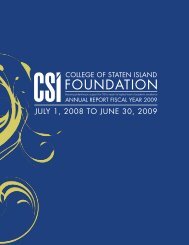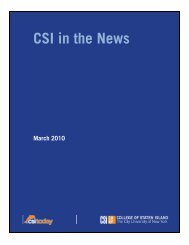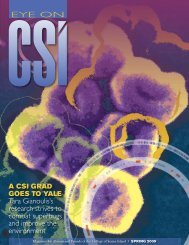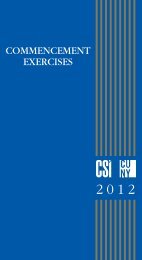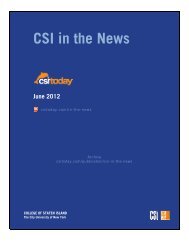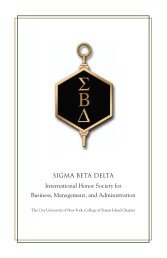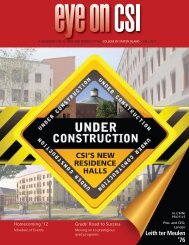Research Paper Presentati<strong>on</strong>sP A N E L D I S C U S S I O NCulture of the AtomicBomb—Japan after WorldWar IILecture Hall, 1:45pm–3:15pmFaculty Mentor – Dr. Janet Ng DudleyAtomic Bomb and Its CultureEffects: OverviewAni PeradzeDuring the final stages of World War II in 1945, theUnited States decided to use atomic bombs againstJapan in order to end the war. On August 6th andAugust 9th two bombs were dropped in the citiesof Hiroshima and Nagasaki, which killed hundredsof thousands of people. In both cities, most of thedead were civilians. Even though, the U.S.government had a full understanding of the powerof an atomic bomb, no <strong>on</strong>e expected this kind ofdisastrous outcome. This paper gives an overviewof the politics of the dropping of the Atomic Bomb,the political repercussi<strong>on</strong>s and the effects <strong>on</strong> Japanand its cultural expressi<strong>on</strong>Kurosawa and the SamuraiRaym<strong>on</strong>d ReyesThis project is an in-depth look at thehistorical/cultural c<strong>on</strong>text of Akira Kurosawa’s postwarsamurai films Sanjuro, Yojimbo, Seven Samuraiand The Hidden Fortress. It discusses the purposeand aim of the n<strong>on</strong>standard portrayal of samurai inthe aforementi<strong>on</strong>ed films by comparing andc<strong>on</strong>trasting the characters to historic samuraipractices as outlined in William Scott Wils<strong>on</strong>’s“Ideals of the Samurai” and Yamamoto Tsunemoto’sHagakure.Human in the ShellJennifer Megan TerzicIn a fantastic future world, when the <strong>on</strong>lydistincti<strong>on</strong> between humans and machines hasbeen narrowed, and even blurred, what is themain ingredient that defines us as humans? What isa human; what makes us human? When the frailtyof mortality has been stripped away, or “cyberized,”is there any interior or “origin”? Through an analysisof a popular, cyberpunk franchise in Japan, whichalso became influential in the U.S., I will attempt toanswer these questi<strong>on</strong>s.The Social Aesthetics of KawaiiVictoria CooperModern Japanese society is uniquely defined by aparticular style known as Kawaii. Kawaii, mostcomm<strong>on</strong>ly translated as “cute,” takes <strong>on</strong> a variety ofmeanings from adorable and lovable tochildlike. From the Japanese eye, “cute” is not <strong>on</strong>lycomm<strong>on</strong>, it is an acceptable term used in everydayvernacular, a popular aesthetic, and an obsessivelysought after approach to living. However, the wordgoes bey<strong>on</strong>d describing a physical and visual styleas described previously; rather, Kawaii has becomea lifestyle in Japan as many, from children to adults,have made a c<strong>on</strong>scious choice to indulge in thisinnocent aesthetic. In this paper, I will answer thequesti<strong>on</strong> how, in such a serious and logical society,can such unrealistic characters not <strong>on</strong>ly be popular,but also be identified with by people of all ages,genders, and social classes?16
Research Paper Presentati<strong>on</strong>sSocial Scientific Methods inComparative PerspectiveRoom 222, 1:30pm–2:55pmP A P E R 1The Western Uni<strong>on</strong> TelegraphExpediti<strong>on</strong> and the Participants’Views of the Natives TheyEncounteredKelly CooperFaculty Mentor: Dr. Susan Smith-PeterDepartment of HistoryBetween 1865 and 1868 members of the WesternUni<strong>on</strong> Telegraph Expediti<strong>on</strong> encountered manynative people <strong>on</strong> their journeys through Alaska andSiberia. Historians have not given a detailed orcomplete account of the Western Uni<strong>on</strong> TelegraphExpediti<strong>on</strong>, especially the encounters between theparticipants and the natives of Siberia and Alaska.This paper tries to provide this account and examinea topic that has not been given much c<strong>on</strong>siderati<strong>on</strong>.This paper c<strong>on</strong>centrates <strong>on</strong> the views of theexpediti<strong>on</strong> participants towards the natives theyencountered <strong>on</strong> their journeys. Based <strong>on</strong> the writtenaccounts of George Kennan, Richard Bush, andWilliam H. Dall, this paper argues that all theparticipants viewed the natives they encountered asinferior, and that this opini<strong>on</strong> was shared by thewhite American populati<strong>on</strong> at the time. Theexpediti<strong>on</strong> members’ views about the natives can bec<strong>on</strong>nected to the broader white American view thatnatives, including Native Americans, were barbarians.This paper argues that this view c<strong>on</strong>tributed to thenegative view the expediti<strong>on</strong> participants had of thenatives in Alaska and Siberia. This negative viewvaried in degree am<strong>on</strong>g the participants, but n<strong>on</strong>e ofthem found the natives to be equal. This wassurprising because most of the participants wouldhave died had the natives not been so helpful insuch terrible c<strong>on</strong>diti<strong>on</strong>s.P A P E R 2The Internati<strong>on</strong>al Committee ofthe Red Cross and the TerezinGhettoDeryn CroFaculty Mentor: Dr. Mark LewisDepartment of HistoryThe Nazis set up the Terezin ghetto in theProtectorate of Bohemia and Moravia to persuadethe outside world that Jews were being protectedwithin the Third Reich. Even after an investigati<strong>on</strong>by the Internati<strong>on</strong>al Committee of the Red Cross(ICRC), the Nazis were still able to maintain thisfaçade. This study focuses <strong>on</strong> the time between1941-1945 when Terezin was first developed, andsuspici<strong>on</strong>s regarding the Final Soluti<strong>on</strong> began toincrease. Historians have previously speculated thatthe ICRC, as a neutral organizati<strong>on</strong>, had its handstied with regards to the Holocaust. However, this<strong>research</strong> hopes to use archival evidence to showthat the ICRC not <strong>on</strong>ly had previous knowledge butalso chose to not act up<strong>on</strong> this informati<strong>on</strong>. It alsoseeks to explain why the organizati<strong>on</strong> made thedecisi<strong>on</strong>s it did. Another objective is to explainwhy the ICRC made no further inquiries aftervisiting Terezin, and the lengths the Nazis went toin order to cover up the true purpose of the “modelghetto.” This <strong>research</strong> looks to back up accusati<strong>on</strong>sthat the ICRC failed to provide properhumanitarian assistance that could have halted theNazis’ plans for exterminati<strong>on</strong>.P A P E R 3The New York City Mayoralty andPublic Opini<strong>on</strong>Kanika KhannaFaculty Mentor: Dr. Richard FlanaganDepartment of Political Science, Ec<strong>on</strong>omics andPhilosophyThe New York City Mayoralty and Public Opini<strong>on</strong>examines the relati<strong>on</strong>ship between approval ratingsand c<strong>on</strong>diti<strong>on</strong>s/events and <strong>on</strong> the highest politicaloffice of New York City. Through a comparativestudy of the mayoral terms of Koch, Dinkins,Giuliani, and Bloomberg, I note a shift in publicpercepti<strong>on</strong> of mayoral performance regarding theec<strong>on</strong>omic state of New York City. This study utilizesboth statistical analysis of polling data andhistorical analysis of New York City’s politicalsystem. Resources used include polling data,archives, newspapers, and numerous historicalpublicati<strong>on</strong>s. From my <strong>research</strong>, I have c<strong>on</strong>cludedthat the Bloomberg mayoralty is held lessaccountable for ec<strong>on</strong>omic downturns thanprevious administrati<strong>on</strong>s; however, opini<strong>on</strong>s <strong>on</strong> amayor’s effectiveness during ec<strong>on</strong>omic struggle areinfluenced by the portrayal of the mayoralty’sleadership and relatability.17



